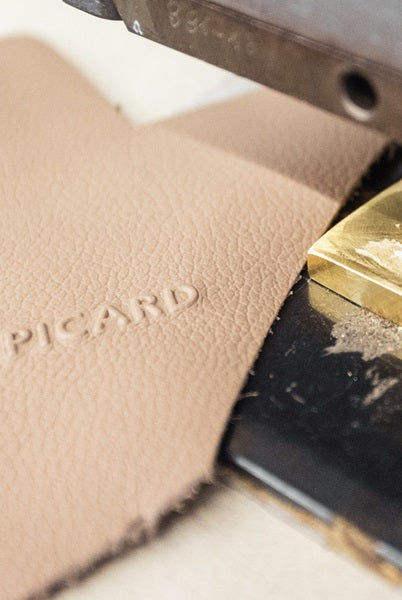Stains are generally an unsightly matter, and it is particularly annoying when they adorn your beautiful leather handbag. Now it is important to know how to get the stains out of the leather.
There are different types of stains, such as oil stains, water stains, blood stains, grease stains, ballpoint pen stains or sunscreen stains and of course there are also different ways to remove these stains from leather.
Why is it important to remove stains from leather?
To ensure that you can enjoy your favorite piece for a long time, it is important to know how to remove leather stains without damaging the leather.
Leather is a natural product that combines many advantages; it is a tear-resistant, durable product that can be a faithful companion in your wardrobe for many years.
This is exactly why it is important to know how to remove stains from leather and what care the leather needs after such cleaning.
Basic tips for removing stains from leather
To remove stains from a leather handbag, you first need to find out what type of stain the piece of jewelry has and then use the appropriate cleaning product.
Removing stains from leather – proper preparation is key
Once the stain has been identified, you can actually start removing the stain. When preparing for and carrying out the cleaning, it is important to find out which cleaning agent is best for which leather and which stain.
Once you've done that, you can start cleaning. To be on the safe side, you should test the cleaning product you've chosen on a small, inconspicuous area before moving on to removing the stain.

In general, you should only use distilled or boiled water to avoid limescale stains. Be careful not to clean the bag too wet.
If you want to use home remedies , you can use
- Baking powder,
- Gall soap,
- Shampoo,
- Baby powder,
- shower gel
- or dishwashing detergent.
Attention: Not all leather is the same
There are many different types of leather , such as:
- Smooth leather,
- Suede,
- suede,
- Nubuck leather and other different types, which differ in their production but also in how they need to be treated.
smooth leather
Smooth leather usually comes from durable cowhide , but buffalo leather or calf leather is also used for production.
Suede
Suede is the name given to leather whose surface has been roughened , such as nubuck leather or suede, but it should not be confused with suede, which is a type of full-grain leather that is made from
- deer,
- Deer
- or moose and has a velvety soft feel.
Suede
Treating grease stains on suede requires a different method than removing stains on smooth leather
Is the grease stain on the suede bag fresh? Then you need to act quickly, grab an absorbent cloth and gently dab the stain to absorb as much of the grease as possible so that it cannot soak in.
Expert tip: Avoid rubbing or scrubbing the stain to avoid making it bigger and destroying the fibers.
The cleaning
Now you should decide whether you want to try a professional leather cleaner or a home remedy . No matter what you want to use, always make sure to dry the handbag thoroughly after cleaning.
- This also works best with an absorbent cloth, which you gently dab onto the cleaned area.
- It is best to clean and dry the suede handbag lying down, but please never dry it on a radiator as this will make the leather brittle.
Expert tip: After cleaning, you should pamper your jewelry with a suitable leather care product.
You need these materials to remove stains from leather
smooth leather
To remove stains from smooth leather using household products, you can have the following utensils ready:
- Curd soap, shampoo or shower gel (please only one of the products mentioned)
- warm water
- absorbent cotton cloth for cleaning
- distilled or boiled water
- Cotton cloth for dabbing dry
- Leather care for aftercare
Suede
To remove stains from suede using household remedies, you can have the following utensils ready:
- Upholstery foam
- Suede brush
- sponge
- Eraser for suede (or a normal eraser, make sure that these are colorless)
- Suede care for treatment after cleaning (please do not confuse with shoe polish)
Suede
To remove stains from suede using household remedies, you can have the following utensils ready:
- Baby powder, dry shampoo (please only use one of the products mentioned)
- Dirt eraser
- Suede care for treatment after cleaning (please do not confuse with shoe polish)
If you decide to use a leather cleaner, use it as directed on the instructions and then treat the leather with a leather conditioner.
6 types of stains on leather and how to remove them
1. Remove water stains from leather
If you have water stains on leather, you should avoid using household remedies . There are many tips and tricks available online, but many of them can damage and attack the leather. Be particularly careful with tips that involve cleaning with
- Onion,
- Vinegar
- or other substances, as these can penetrate the leather and cause an unpleasant smell.
If you get caught in a rain shower and your handbag gets caught in the rain, you need to act quickly. When you get home, regardless of whether it is made of smooth or suede leather, you should quickly dry your handbag with a dry, absorbent cotton cloth , taking care not to rub the leather.

You can simply dab your smooth leather handbag dry with an absorbent cloth. If there are water stains on suede or rough leather, you should gently dab the bag dry and then clean it with a cleaner specifically designed for your leather.
We recommend getting a suede cleaner for water stains and cleaning the bag according to the instructions. Please always test the product on a small, inconspicuous area first.
2. Remove oil stains from leather
Don't worry, even oil stains on leather can usually be easily removed . Smooth leather and suede can be cleaned very well with baby powder .
- Simply sprinkle the stain with baby powder and let it work,
- The powder absorbs the oil and can then be removed by shaking, tapping or brushing.
- Dry shampoo is also excellent for this and is a really hot tip for removing oil stains from leather.
3. Remove blood stains from leather
If the blood stain is fresh, you can dab it with a cloth and cold water, but please do not rub it so as not to make the stain bigger and push the blood deeper into the surface.
Here too, you can find household tips on the Internet that are supposed to help, but they are really radical and can damage the leather. That's why it's recommended to get a professional leather cleaner on board.
4. Remove ballpoint pen from leather
If you do a little research on the Internet, you will find tips on how to remove ballpoint pen from leather using lemon.
- Dilute lemon heavily with water
- or placing a disc on the stain is advisable.
But here too, caution is advised, because lemon contains acid , which can injure and damage the surface.
To be on the safe side, you should choose a leather cleaner that suits the leather of your favorite piece. Several of these cleaners contain citric acid and lemon oils, but these have been professionally mixed and balanced.
Fine sandpaper and a special dirt eraser are also part of these cleaners. After every cleaning, you should pamper your leather with a leather care product .
5. Remove grease stains from leather
Dried grease stains on smooth leather can usually be easily treated with gall soap.
- To remove the grease stains from the leather, dab a little gall soap on the stain and let it work for a short time,
- Then take a damp cloth and gently dab the stain.
- Let the leather dry slowly and then treat it with leather care.
For fresh grease stains , you can proceed as for oil stains and treat the stain with baby powder or dry shampoo .
Raw potatoes can also remove the grease stain from the leather.
- To do this, simply cut open a potato and dab the stain with it.
- Once the remaining starch has dried, you can gently brush it off with a soft brush.
- You can remove old grease stains with a dirt eraser. But here too, it is particularly important that you do not rub too hard.
6. Remove sunscreen from leather
You can also treat sunscreen stains on smooth leather with baking soda or baby powder; proceed as described above.
However, it is also recommended to treat the leather with a leather cleaner that is tailored to the particular type of leather.
These home remedies help with stains on leather
- Water stains suede -> cotton cloth and distilled water
- Water stains on smooth leather -> cotton cloth and distilled water
- Grease and oil stains (fresh) suede -> baby powder, baking soda, dry shampoo
- Grease and oil stains (fresh) smooth leather -> baby powder, baking powder, dry shampoo
- Grease and oil stains (old) suede -> dirt eraser
- Grease and oil stains (old) smooth leather -> gall soap
If these methods are too delicate for you and you want to be on the safe side, use a leather cleaner that is tailored to the leather of your piece of jewelry and then pamper it with a rich care product.
Light or dark leather – what to consider
Regardless of whether the leather is light or dark , a good waterproofing is essential, as it can prevent a lot of damage. However, especially with light leather colours, jeans or belts can transfer colour to the leather.
In general, you can also use the household tips mentioned above for light-colored leather , but it is important that you choose products that are as colorless as possible.
When drying, you should also make sure that light-colored leather is dried on a non-staining surface and never on a heater or exposed to direct sunlight.
How do you remove stains from light leather?
When removing stains from light-colored leather, make sure to use colorless or white cleaning products. An important rule of thumb is that you don't clean the leather too wet and that you use a neutral soap.

How do you remove stains from dark leather?
When removing stains from dark leather, you should also use a colorless cleaner if possible. If you want to remove grease or oil stains, for example, you can use a dry shampoo for dark hair and proceed as described above.
4 general tips for caring for leather products
To ensure that your piece of jewelry lasts a long time and to care for it, you can waterproof it. This protects the fine leather and is a major part of leather care. Because good waterproofing is usually half the battle.
1. Regular cleaning
You can regularly clean your leather with a damp cloth or baby wipes and remove dust and dirt.
You can give the leather a spring cleaning every 6-12 months.
2. Use of leather care products
There are so many different ways to care for leather, but you probably have many home remedies that your leather will like, such as
- Baby powder,
- Dry shampoo
- or gall soap.
So you don’t necessarily have to resort to professional leather care to do something good for your leather.
To give your leather what it needs, you can of course expand your household cupboard to include leather care milk and leather care products and then use these for the spring cleaning of the leather.
Please always make sure that you choose cleaners specifically for the leather of your handbag and test them on a small, inconspicuous area before cleaning the entire bag.
3. Protection from sunlight and moisture
Leather should not be constantly exposed to direct sunlight, as this can quickly make it brittle and dry. It is also important to protect it from moisture, as this can cause it to wrinkly and wrinkle and cause mildew or mold spots to form.
4. Storage of leather products
Proper storage of leather products is crucial to maintaining their quality and durability.
Your leather handbag should not be exposed to high temperatures or stored in rooms with high humidity. Protect it from direct sunlight and do not hang it above a heater.
Ideally , leather should be stored in a cool, dry, dark and well-ventilated room. Leather should never be stored in plastic bags or pouches as this will prevent the material from breathing and may lead to the formation of mould.
Instead, leather products should be stored in cloth bags or paper bags to protect them from dust and dirt.
Conclusion
Stains on leather are annoying, but with the right knowledge and methods they can be removed without damaging the material.
There are different types of stains, each requiring a specific cleaning method . However, before you start cleaning, you should make sure you are using the right cleaning product for your specific leather and stain. Also, you should always test how your leather reacts to the selected cleaning product on an inconspicuous area first.
It is important to know what type of leather you have. This is the only way to choose the right cleaning product . Suede requires a different treatment than smooth leather, and suede should not be dried on a radiator, for example, as it can become brittle.
Leather is a natural product with many benefits and can be a long-lasting companion if it is well cared for and cleaned properly. This is precisely why good preparation for removing stains is essential.
FAQ on the topic: Removing stains from leather
What does vinegar do to leather?
Vinegar can dry out and damage leather if not diluted properly. Too much vinegar can fade the leather color and make the leather hard and brittle.
- If you want to use vinegar on leather, you should always dilute it with water in a ratio of 1:1 and not apply it directly to the leather,
- Instead, put it on a soft cloth and gently dab it onto the stain.
- It is also important to clean the leather thoroughly after using vinegar and treat it with leather conditioner to prevent it from drying out.
What damages the leather?
Leather is a natural material and can be damaged by various factors. The most common causes of damage to leather include
- Humidity,
- Heat,
- UV radiation
- and wear and tear.
When leather is exposed to moisture , it can discolor, swell or even mold .
Heat can dry out leather and make it brittle, while UV rays can cause the leather to fade or change color. Over-stressing the leather or cleaning it incorrectly can cause the leather to crack or break.
To keep the leather in good condition, you should handle it carefully . You should protect it from moisture and not store it in direct sunlight or near heat sources. Also avoid putting too much strain on the leather and clean it regularly with suitable care products . This way, your favorite piece will remain durable and resistant.








